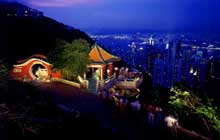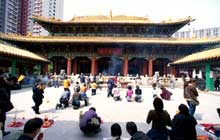
 Victoria Peak
Victoria Peak
If you picture Hong Kong as a dragon, with qi or energy coursing through it, then Victoria Peak is the summit of the dragon's spine; and the Peak is unquestionably Hong Kong 's premier tourist site. If you visit in summer you'll no doubt sympathize with Sir Richard MacDonnell, a Governor of Hong Kong in the nineteenth century, who moved his residence there to avoid the tropical torpor down by the harbor. Since Sir Richard's day a few more buildings have gone up and it is no longer a simple look-out, but a multi-storey complex of shops, restaurants, and a Madame Tussaud's waxworks (with Jackie Chan, of course). But it's the view that one goes for. Day or night the vista over the harbor, with the buildings slowly crawling up the hill toward you, is breathtaking. You can drive to the Peak, or join many other tourists on the funicular (a cable railway with two cars balancing each other as they move in opposite directions) that runs at such an angle that it is difficult to believe that Hong Kong 's buildings are vertical and not shooting out at all angles. From the terminus you can take the escalators to the top viewing platform.
Government House
Built in 1855 and extended by the Japanese during their four years of rule in Hong Kong this charming neo-classical building served as the residence for 25 of Hong Kong 's Governors. When the British left in 1997 the building was abandoned, but beginning in 2006 the building resumed its purpose. Now it once again houses Hong Kong's political leader, this time the Chief Executive of the SAR who would, no doubt, sympathize with the sentiment of the British Governor of 1919-25, Sir Reginald E Stubbs, who advised keeping any leanings of the local population toward democracy 'within the bounds of reason'. It remains to be seen whether it will host the luminaries it has in days gone by, counting among its visitors the yet to be crowned Tsar Nicolas II, and the former US President Ulysses Grant.

The Tin Hau and Man Mo Temples
One of the most striking facets of Hong Kong is that a city that appears so thoroughly modern preserves so many small temples and functions as one of the de facto centers of the Chinese art of Feng Shui. The two worlds may not be as separate as they appear and many of Hong Kong 's landmark buildings have been designed with feng shui principles in mind. None of the buildings, however, can compete with a site near the Lung Cheung Road Lookout, on the Kowloon Peninsula , where they say the dragon energy that has ensured Hong Kong 's success is thickest. To get a feel for the original culture that flourishes yet in Hong Kong then visit a Tin Hau or Hung Sin Temple, both being gods of the sea. The Tin Hau Temple in Causeway Bay , built initially in the early eighteenth century, is still in the hands of the family who put it up. Just around the corner is the Lotus Temple – a terrific example of a small local temple where if you back up to admire the view you'll bump into a pillar. The Lotus Temple has monks, the delightful coiled cone incense, and is a fine place to see how ancestor worship, religious worship, and scholarship all come together – in this Buddhist temple, in the spirit of Pascal's Wager, there is also a statue of Confucius in one of the side temples on the way up. The best-known Daoist temple is the Man Mo Temple, a Hong Kong landmark that is popular with everyone, regardless of whether they are Daoist or not. The Temple was constructed during the middle of the nineteenth century and dedicated to the twin gods of literature and the martial arts – a telling sign of how important those two attributes became in Chinese culture is that positions in the imperial governments were often divided along those lines; and if you place the Chinese characters for 'literature' and 'martial' side by side the resultant character means refined.
The Outlying Islands
If you feel like escaping the concrete and skyscrapers in search of an older Hong Kong then the outlying islands make for an interesting experience. Many preserve a way of life that is almost unimaginable amidst the offices in Central. From Cheung Chau with its still functioning fishing village to Lantau with its exhilarating walks on well-defined trails, and quaint villages. The scenery can be stark on the slopes yet tropically lush by the shore – wherever you walk you'll soon enough come face to face with the realization that Hong Kong 's extraordinary growth has come about despite lacking supplies of fresh water and arable land. Lantau is also home to the largest Buddha in the area, known unsurprisingly as the Big Buddha, which can now be visited via an extraordinary cable-car journey that begins near the airport and winds its way for nearly 6km up to the Po Lin Monastery. In a curious Western juxtaposition, that Hong Kong seems so good at throwing up, Lantau boasts both a Disneyland and a Trappist Monastery; the latter used to make fresh milk, known as 'Priest Milk', on site.